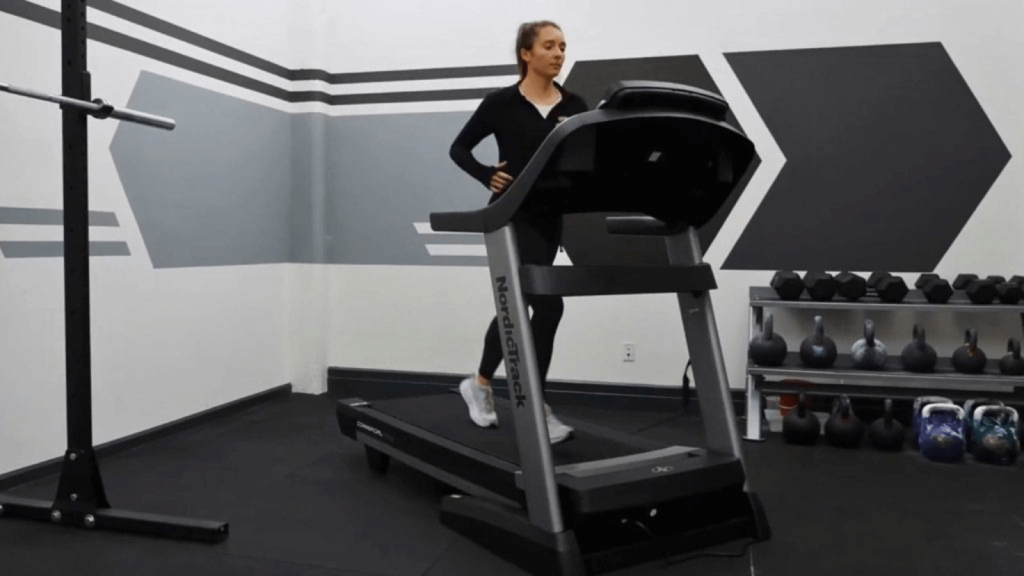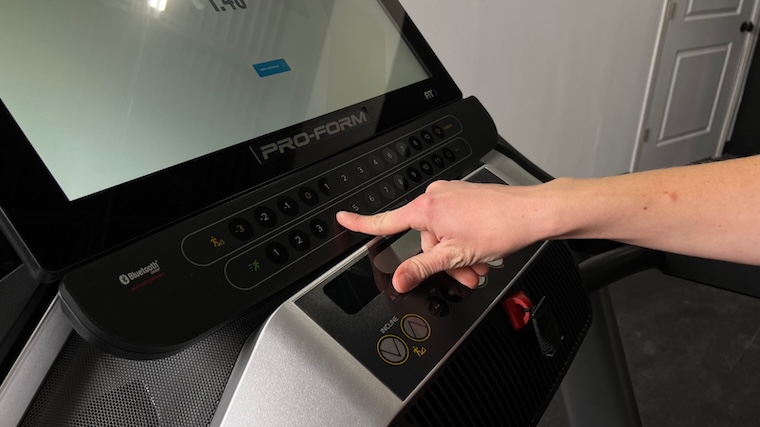When you’ve got one of the best treadmills that can help you control every aspect of your training — from pace to variations in incline and decline — understanding how to use a treadmill pace chart can further elevate your routine and allow you to dial in a specific running pace.
Rather than hopping on a treadmill and winging it, use a treadmill pace chart to set the exact training metrics for your cardio session. Whether you’re new to running or a seasoned athlete, we’ve got the speed conversions and some suggested workouts to help your training.
Understanding Treadmill Pace and Speed
Treadmill pace is your speed, or how fast or slow you’re moving, on a treadmill. This is measured in miles per hour (mph) or kilometers per hour (kph). Minutes per mile is a popular way to track treadmill pace, helping you track the time it takes to cover that distance. Using and understanding speed and pace settings on a treadmill can help you track your progress, train for an outdoor race, and set goals for your workout.
Factors Affecting Pace and Speed
Unlike outdoor running, where the grade of terrain can fluctuate and headwinds and heat waves can slow your pace, the variables affecting your treadmill training — the speed, incline, and climate — are in your control.
What is a Treadmill Pace Chart?
A treadmill pace conversion chart is a reference table, as seen below, that shows you how a treadmill’s speed settings affect your pace in minutes per mile. This chart shows the setting you can select on a treadmill to choose your speed, from 1 to 15 miles per hour.

While many of the best treadmills for running top out at 12 miles per hour max speed, some commercial treadmills offer speeds up to 15 miles per hour. The pace column on the right shows how much time it would take to run (or walk) a mile at that treadmill speed setting.
| Treadmill MPH | Pace (Min/Mile) |
| 1 | 60:00 |
| 1.5 | 40:00 |
| 2 | 30:00 |
| 2.5 | 24:00 |
| 3 | 20:00 |
| 3.5 | 17:08 |
| 4 | 15:00 |
| 4.5 | 13:20 |
| 5 | 12:00 |
| 5.5 | 10:55 |
| 6 | 10:00 |
| 6.5 | 9:14 |
| 7 | 8:34 |
| 7.5 | 8:00 |
| 8 | 7:30 |
| 8.5 | 7:03 |
| 9 | 6:40 |
| 9.5 | 6:19 |
| 10 | 6:00 |
| 10.5 | 5:43 |
| 11 | 5:27 |
| 11.5 | 5:13 |
| 12 | 5:00 |
| 12.5 | 4:48 |
| 13 | 4:38 |
| 13.5 | 4:27 |
| 14 | 4:17 |
| 14.5 | 4:08 |
| 15 | 4:00 |
Since these charts can be difficult to read at first glance, we made a simplified version with whole and half numbers for the treadmill speed to give you a basic understanding of paces. If you’d like a more in-depth chart that covers how equivalent pace is affected based on incline and a wider range of mph settings, hillrunner.com has a chart that may suit your needs.
Benefits of Using a Treadmill Pace Chart
Whether you’re looking to simplify your workout or prepare for a 5k Turkey Trot — you’ve got your eyes set on finally beating your hometown rival — a treadmill pace chart provides you with the information you need to train with purpose. Here are a few of the benefits of these charts.
Precise Training Plans
“Treadmills offer runners a more controlled environment for training,” says Amanda Capritto, our expert reviewer. Depending on the type of treadmill you’re working with, the ability to choose your treadmill incline and speed puts your training in your control, as compared to running on hills or flat ground outdoors.

One thing to note is that running outdoors can often be harder than running on a treadmill. On an indoor treadmill, there’s a lack of wind resistance, the temperature can be controlled, and the incline is up to your choosing. It’s worth taking this into consideration when planning out your training.
By understanding your desired training, a treadmill pace chart allows you to follow specific training plans to support your goals. Whether you’re wanting to do 30-second sprints to spike your heart rate or increase your mile time from your last effort, you’ll be armed with the exact treadmill mph you need to set your treadmill to to tackle the work ahead.
Race Preparation
“Even the most experienced runners can struggle to maintain the pace they should be training at when running outdoors, whether they’re supposed to be holding a steady zone two or alternating between zone one and zone four intervals,” says Capritto.
When I was training for the Senshuu International Marathon in Osaka, Japan, I knew I had to take my training seriously because I’d been warned that if I didn’t maintain a certain pace, the race would load me onto a “shame bus” and I wouldn’t be allowed to finish.

While you may not be weary of a “shame bus” scooping you up and bringing dishonor to your family, a pace chart can help you understand what speed your running workout should be at to reach your goal. For example, if your half-marathon training has the end goal of a sub-two-hour race time, to make that race time you should be running at about a 9-minute mile pace. (1) Using a setting between 6 and 7 miles per hour —about 6.7 miles per hour— on a treadmill would provide you with a 9-minute mile pace.
Ease and Consistency From One Run to the Next
Using a pace chart supports consistent training, allowing you to know how fast you’re running from one session to the next. Plus, the simplicity of being able to press a button that sets your pace and take-off is a win in our books. “A tread offers a set-it-and-forget-it running environment, which can take a lot of the mental tax out of running,” says Capritto.
Sample Treadmill Running Workouts
Below are some running workouts you can try if you’re interested in increasing your speed and improving your overall conditioning. Since everyone is different, we won’t tell you exactly what numbers to set on your treadmill, but instead how you should feel during each part of the workout.
Once you’ve figured out appropriate settings for your treadmill, be sure to mark them down so when you repeat the workout later, you can aim to match or beat your previous effort.
Hill Workout
From improving muscle strength and VO2 max to increasing speed and mental toughness, a hill-running workout is a great way to tackle training on a treadmill. (2) The trick here will be to take advantage of your recovery so you’ll be ready for each hill sprint.

- Warm-up: Start with a five-minute warm up to get your body primed for hill work. This should be an easy jog where your heart rate isn’t too elevated from your resting heart rate.
- Incline Interval: Once you’re warm and ready, set your incline to 5% and aim to double your speed. If you were previously jogging at 2 or 3 miles per hour, try upping the speed to 4 or 5 miles per hour. Stay on this setting for 2 minutes.
- Recover: When two minutes are up, reduce your incline back to zero percent and bring your speed back to your warm-up speed. Spend two minutes here, allowing your heart rate to lower, before going back into a hill run.
Repeat this workout, running hills and then recovering, for 20 minutes before taking five minutes to cool down.
The 5-4-3-2-1 Workout
This run is a HIIT treadmill workout where you’ll be switching your intensity throughout.
- For five minutes: Start off with a warm-up jog to get your body ready for the work.
- For four minutes: Up the speed to bring yourself to a casual run. You should still be able to carry a conversation, this isn’t max effort.
- For three minutes: Up the speed to a faster pace. You’ll recover after this round, so up your speed to a challenging level you can maintain for the entire duration.
- For two minutes: Drop the speed back down to your initial jog speed or even slower. It’s time to recover.
- For one minute: Slow your pace all the way down to a comfortable walking speed.
FAQs: Treadmill Pace Chart
How fast is 6.5 on a treadmill?
Running on a treadmill without any incline, a speed of 6.5 miles per hour will put you at a 9:14 mile pace.
Is walking on a treadmill at 3.5 miles per hour good?
A speed of 3.5 miles per hour on a treadmill is a moderate pace and doing this sort of exercise for 30 minutes a day can put you on track to tackle the recommended 150 minutes of moderate exercise a week. (3)
How fast is 10.0 on a treadmill?
Running at 10 miles per hour on a treadmill is a six-minute mile pace.
What are some running tips to improve my speed?
Using a treadmill pace chart, keep track of your speed and effort from one workout to the next. This way, you’ll be able to push yourself and increase your speed from week to week. Additionally, you can incorporate speed workouts and hill sprints to help your body adapt and become accustomed to faster speeds.
References
- Half Marathon Pace Chart. (n.d.) https://www.trackshack.com/uploads/files/1364580732-mFUQsHze.pdf.
- Lember, L. M., Di Virgilio, T. G., Brown, E. M., & Rodriguez-Sanchez, N. (2021). Hill Runner’s Physiology, Performance and Nutrition: A Descriptive Study. Frontiers in sports and active living, 3, 676212. https://doi.org/10.3389/fspor.2021.676212
- American Heart Association recommendations for physical activity in adults and kids. www.heart.org. (2024, January 19). https://www.heart.org/en/healthy-living/fitness/fitness-basics/aha-recs-for-physical-activity-in-adults